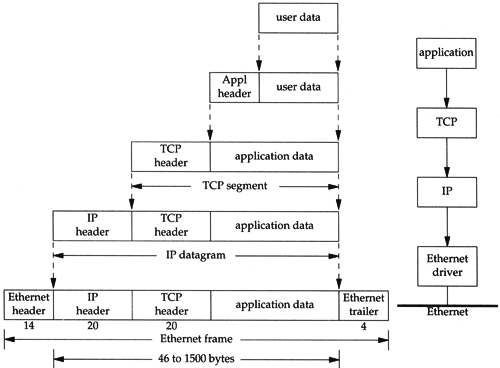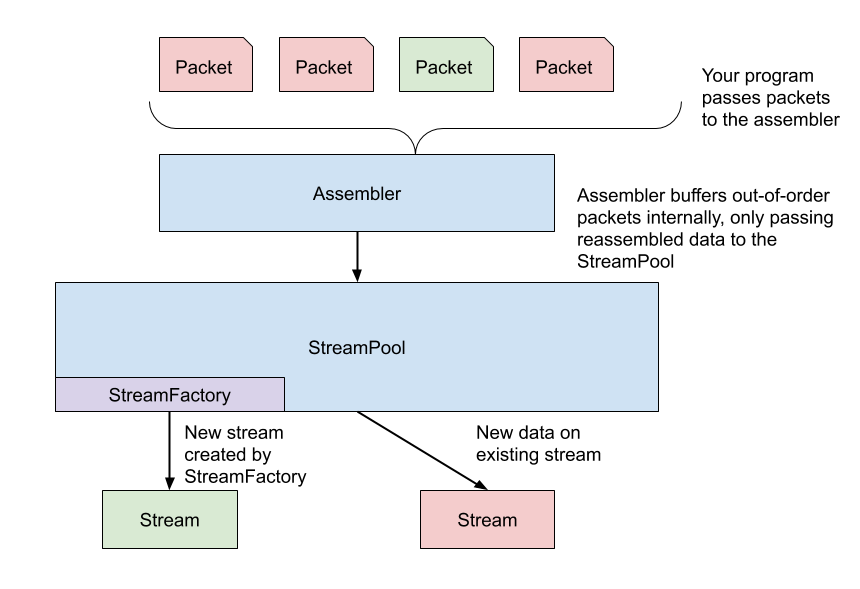0x00 前言
项目中需要实现一些基本的流量分析功能,借用了 gopacket 库,该库是 libpcap 和 npcap 的 go 封装,提供了更方便的 go 语言操作接口。通常网络抓包有以下几个步骤:
- 枚举主机上网络设备的接口
- 针对某一网口进行抓包
- 解析数据包的 mac 层、ip 层、tcp/udp 层字段等
- ip 分片重组,或 tcp 分段重组成上层协议如 http 协议的数据
- 对上层协议进行头部解析和负载部分解析
应用场景
- 网络流量分析:对网络设备流量进行实时采集以及数据包分析
- 伪造数据包发送
- 离线 pcap 文件的读取和写入
- 从网络接口收集数据包(tcpdump)
- 重新组装 TCP 流(Wireshark)
libpcap 原理

回顾下 libpcap 包处理路径,libpcap 包捕获机制是在数据链路层增加一个旁路处理,并不干扰系统自身的网路协议栈的处理,对发送和接收的数据包通过 Linux 内核做过滤和缓冲处理,最后直接传递给上层应用程序。 libpcap 在捕获到达网卡的数据包后绕开了传统 linux 协议栈处理,直接使用链路层 PF_PACKET 协议族原始套接字方式向用户空间传递报文
libpcap 主要由网络分接头(Network Tap)和数据过滤器(Packet Filter)构成,网络分接头从网络设备驱动程序(NIC driver)中收集数据拷贝,过滤器决定是否接收该数据包。Libpcap 的工作原理可以描述为,当一个数据包到达网卡时,通过网络分接口(即旁路机制)将数据包发给 BPF(BSD Packet Filter)过滤器,匹配通过的数据包可以被 libpcap 利用创建的套接字 PF_PACKET 从链路层驱动程序中获得。进而在用户空间提供独立于系统的用户级 API 接口,用户程序获取报文后可以做相关处理
0x01 gopacket 基础
以 TCP 报文为例,其在协议栈上的格式如下图所示,从 libpcap 拿到的原始数据是 Ethernet 层,然后逐层向上面解码,最终拿到开发者想要的数据(协议栈层次、应用数据等)

所以,需要熟练掌握如下知识点:
- 协议(报文)格式,比如 IP 层的 protocol 字段标识了其上层是何种协议,从而实现解析报文
- TCP 会话重组:由于 TCP 是流式协议,完整的解析 TCP 需要实现重组功能
gopacket 的子包(主要)功能如下:
- layers:包含内置于 gopacket 的用于解码数据包协议的逻辑,常用
- pcap:使用 libpcap 从网络读取数据包的 C 绑定,可以用来读取 / 写入 pcap 数据包
- pfring:使用
PF_RING从网络读取数据包的 C 绑定 - afpacket:从网络上读取数据包的 Linux
AF_PACKET的 C 绑定 - tcpassembly:TCP 流重组,建议使用 reassembly,这个库较新
基础示例
基础使用可以参考 Basic_Usage、examples 下面的代码
例子 1:设置过滤器 tcp and port 80 抓包
var (
device string = "eth1"
snapshot_len int32 = 1024
promiscuous bool = false
err error
timeout time.Duration = 30 * time.Second
handle pcap.Handle
)
func main() {
// Open device
handle, err := pcap.OpenLive(device, snapshot_len, promiscuous, timeout)
if err != nil {
log.Fatal(err)
}
defer handle.Close()
// Set filter
var filter string = "tcp and port 80"
err = handle.SetBPFFilter(filter)
if err != nil {
log.Fatal(err)
}
fmt.Println("Only capturing TCP port 80 packets.")
packetSource := gopacket.NewPacketSource(handle, handle.LinkType())
for packet := range packetSource.Packets() {
// Do something with a packet here.
fmt.Println(packet)
}
}
例子 2:调用 layers 解码,作者已经提供了诸如 LayerTypeEthernet/IP/UDP/TCP 等众多 layer 创建了相应类型,参考 layers;以 dns 协议为例,其格式定义 为
// BaseLayer is a convenience struct which implements the LayerData and
// LayerPayload functions of the Layer interface.
type BaseLayer struct {
// Contents is the set of bytes that make up this layer. IE: for an
// Ethernet packet, this would be the set of bytes making up the
// Ethernet frame.
Contents []byte
// Payload is the set of bytes contained by (but not part of) this
// Layer. Again, to take Ethernet as an example, this would be the
// set of bytes encapsulated by the Ethernet protocol.
Payload []byte
}
// DNS is specified in RFC 1034 / RFC 1035
// +---------------------+
// | Header |
// +---------------------+
// | Question | the question for the name server
// +---------------------+
// | Answer | RRs answering the question
// +---------------------+
// | Authority | RRs pointing toward an authority
// +---------------------+
// | Additional | RRs holding additional information
// +---------------------+
//
// DNS Header
// 0 1 2 3 4 5 6 7 8 9 0 1 2 3 4 5
// +--+--+--+--+--+--+--+--+--+--+--+--+--+--+--+--+
// | ID |
// +--+--+--+--+--+--+--+--+--+--+--+--+--+--+--+--+
// |QR| Opcode |AA|TC|RD|RA| Z | RCODE |
// +--+--+--+--+--+--+--+--+--+--+--+--+--+--+--+--+
// | QDCOUNT |
// +--+--+--+--+--+--+--+--+--+--+--+--+--+--+--+--+
// | ANCOUNT |
// +--+--+--+--+--+--+--+--+--+--+--+--+--+--+--+--+
// | NSCOUNT |
// +--+--+--+--+--+--+--+--+--+--+--+--+--+--+--+--+
// | ARCOUNT |
// +--+--+--+--+--+--+--+--+--+--+--+--+--+--+--+--+
// DNS contains data from a single Domain Name Service packet.
type DNS struct {
BaseLayer
// Header fields
ID uint16
QR bool
OpCode DNSOpCode
AA bool // Authoritative answer
TC bool // Truncated
RD bool // Recursion desired
RA bool // Recursion available
Z uint8 // Reserved for future use
ResponseCode DNSResponseCode
QDCount uint16 // Number of questions to expect
ANCount uint16 // Number of answers to expect
NSCount uint16 // Number of authorities to expect
ARCount uint16 // Number of additional records to expect
// Entries
Questions []DNSQuestion
Answers []DNSResourceRecord
Authorities []DNSResourceRecord
Additionals []DNSResourceRecord
// buffer for doing name decoding. We use a single reusable buffer to avoid
// name decoding on a single object via multiple DecodeFromBytes calls
// requiring constant allocation of small byte slices.
buffer []byte
}
数据包解码的代码如下,其中的核心是 packet.Layer方法:
var (
device string = "eth0"
snapshotLen int32 = 1024
promiscuous bool = false
err error
timeout time.Duration = 30 * time.Second
handle pcap.Handle
)
func main() {
// Open device
// 对网卡流量进行实时捕获
handle, err := pcap.OpenLive(device, snapshotLen, promiscuous, timeout)
if err != nil {
log.Fatal(err)
}
// 需要关闭
defer handle.Close()
packetSource := gopacket.NewPacketSource(handle, handle.LinkType())
// packetSource.Packets 返回一个 channel
for packet := range packetSource.Packets() {
printPacketInfo(packet)
}
}
func printPacketInfo(packet gopacket.Packet) {
// Let’s see if the packet is an ethernet packet
ethernetLayer := packet.Layer(layers.LayerTypeEthernet)
if ethernetLayer != nil {
fmt.Println("Ethernet layer detected.")
ethernetPacket, _ := ethernetLayer.(*layers.Ethernet)
fmt.Println("Source MAC:", ethernetPacket.SrcMAC)
fmt.Println("Destination MAC:", ethernetPacket.DstMAC)
// Ethernet type is typically IPv4 but could be ARP or other
fmt.Println("Ethernet type:", ethernetPacket.EthernetType)
fmt.Println()
}
// Let’s see if the packet is IP (even though the ether type told us)
ipLayer := packet.Layer(layers.LayerTypeIPv4)
if ipLayer != nil {
fmt.Println("IPv4 layer detected.")
ip, _ := ipLayer.(*layers.IPv4)
// IP layer variables:
// Version (Either 4 or 6)
// IHL (IP Header Length in 32-bit words)
// TOS, Length, Id, Flags, FragOffset, TTL, Protocol (TCP?),
// Checksum, SrcIP, DstIP
fmt.Printf("From %s to %s\n", ip.SrcIP, ip.DstIP)
fmt.Println("Protocol:", ip.Protocol)
fmt.Println()
}
// Let’s see if the packet is TCP
tcpLayer := packet.Layer(layers.LayerTypeTCP)
if tcpLayer != nil {
fmt.Println("TCP layer detected.")
// Get actual TCP data from this layer
tcp, _ := tcpLayer.(*layers.TCP)
// TCP layer variables:
// SrcPort, DstPort, Seq, Ack, DataOffset, Window, Checksum, Urgent
// Bool flags: FIN, SYN, RST, PSH, ACK, URG, ECE, CWR, NS
fmt.Printf("From port %d to %d\n", tcp.SrcPort, tcp.DstPort)
fmt.Println("Sequence number:", tcp.Seq)
fmt.Println()
}
// Iterate over all layers, printing out each layer type
fmt.Println("All packet layers:")
for _, layer := range packet.Layers() {
fmt.Println("-", layer.LayerType())
}
// When iterating through packet.Layers() above,
// if it lists Payload layer then that is the same as
// this applicationLayer. applicationLayer contains the payload
applicationLayer := packet.ApplicationLayer()
if applicationLayer != nil {
fmt.Println("Application layer/Payload found.")
fmt.Printf("%s\n", applicationLayer.Payload())
// Search for a string inside the payload
if strings.Contains(string(applicationLayer.Payload()), "HTTP") {
fmt.Println("HTTP found!")
}
}
// Check for errors
if err := packet.ErrorLayer(); err != nil {
fmt.Println("Error decoding some part of the packet:", err)
}
}
0x02 代码分析
Packet 是数据解码器的公共接口实现,packet 作为其 实例化,gopacket 提供了这几种内置解码器:
eagerPacket:lazyPacket:
1、Packet
// Packet is the primary object used by gopacket. Packets are created by a
// Decoder's Decode call. A packet is made up of a set of Data, which
// is broken into a number of Layers as it is decoded.
type Packet interface {
//// Functions for outputting the packet as a human-readable string:
//// ------------------------------------------------------------------
// String returns a human-readable string representation of the packet.
// It uses LayerString on each layer to output the layer.
String() string
// Dump returns a verbose human-readable string representation of the packet,
// including a hex dump of all layers. It uses LayerDump on each layer to
// output the layer.
Dump() string
//// Functions for accessing arbitrary packet layers:
//// ------------------------------------------------------------------
// Layers returns all layers in this packet, computing them as necessary
Layers() []Layer
// Layer returns the first layer in this packet of the given type, or nil
Layer(LayerType) Layer
// LayerClass returns the first layer in this packet of the given class,
// or nil.
LayerClass(LayerClass) Layer
//// Functions for accessing specific types of packet layers. These functions
//// return the first layer of each type found within the packet.
//// ------------------------------------------------------------------
// LinkLayer returns the first link layer in the packet
LinkLayer() LinkLayer
// NetworkLayer returns the first network layer in the packet
NetworkLayer() NetworkLayer
// TransportLayer returns the first transport layer in the packet
TransportLayer() TransportLayer
// ApplicationLayer returns the first application layer in the packet
ApplicationLayer() ApplicationLayer
// ErrorLayer is particularly useful, since it returns nil if the packet
// was fully decoded successfully, and non-nil if an error was encountered
// in decoding and the packet was only partially decoded. Thus, its output
// can be used to determine if the entire packet was able to be decoded.
ErrorLayer() ErrorLayer
//// Functions for accessing data specific to the packet:
//// ------------------------------------------------------------------
// Data returns the set of bytes that make up this entire packet.
Data() []byte
// Metadata returns packet metadata associated with this packet.
Metadata() *PacketMetadata
}
2、Layer:抽象了协议层次,gopacket 提供了如下几类:
LinkLayer: the packet layer corresponding to TCP/IP layer 1 (OSI layer 2)NetworkLayer:the packet layer corresponding to TCP/IP layer 2 (OSI layer 3),实例化参考 ipv4TransportLayer:is the packet layer corresponding to the TCP/IP layer 3 (OSI layer 4),实例化参考 tcpApplicationLayer:the packet layer corresponding to the TCP/IP layer 4 (OSI layer 7), also known as the packet payloadErrorLayer:a packet layer created when decoding of the packet has failed
// Layer represents a single decoded packet layer (using either the
// OSI or TCP/IP definition of a layer). When decoding, a packet's data is
// broken up into a number of layers. The caller may call LayerType() to
// figure out which type of layer they've received from the packet. Optionally,
// they may then use a type assertion to get the actual layer type for deep
// inspection of the data.
type Layer interface {
// LayerType is the gopacket type for this layer.
LayerType() LayerType
// LayerContents returns the set of bytes that make up this layer.
LayerContents() []byte
// LayerPayload returns the set of bytes contained within this layer, not
// including the layer itself.
LayerPayload() []byte
}
0x03 TCP 流重组
TCP 流重组的代码在 此
httpassembly
这里简单分析下 httpassembly 的实现
1、核心结构
// Build a simple HTTP request parser using tcpassembly.StreamFactory and tcpassembly.Stream interfaces
// httpStreamFactory implements tcpassembly.StreamFactory
type httpStreamFactory struct{}
// httpStream will handle the actual decoding of http requests.
type httpStream struct {
net, transport gopacket.Flow
r tcpreader.ReaderStream
}
func (h *httpStreamFactory) New(net, transport gopacket.Flow) tcpassembly.Stream {
hstream := &httpStream{
net: net,
transport: transport,
r: tcpreader.NewReaderStream(),
}
go hstream.run() // Important... we must guarantee that data from the reader stream is read.
// ReaderStream implements tcpassembly.Stream, so we can return a pointer to it.
return &hstream.r
}
而重组的逻辑如下:
- 收包并组装
AssembleWithTimestamp - 超时清理
FlushOlderThan
func main() {
// ...
streamFactory := &httpStreamFactory{}
streamPool := tcpassembly.NewStreamPool(streamFactory)
assembler := tcpassembly.NewAssembler(streamPool)
log.Println("reading in packets")
// Read in packets, pass to assembler.
packetSource := gopacket.NewPacketSource(handle, handle.LinkType())
packets := packetSource.Packets()
ticker := time.Tick(time.Minute)
for {
select {
case packet := <-packets:
// A nil packet indicates the end of a pcap file.
if packet == nil {
return
}
if *logAllPackets {
log.Println(packet)
}
if packet.NetworkLayer() == nil || packet.TransportLayer() == nil || packet.TransportLayer().LayerType() != layers.LayerTypeTCP {
log.Println("Unusable packet")
continue
}
tcp := packet.TransportLayer().(*layers.TCP)
assembler.AssembleWithTimestamp(packet.NetworkLayer().NetworkFlow(), tcp, packet.Metadata().Timestamp)
case <-ticker:
// Every minute, flush connections that haven't seen activity in the past 2 minutes.
assembler.FlushOlderThan(time.Now().Add(time.Minute * -2))
}
}
}
reassemblydump
reassemblydump 展示了如何使用 gopacket 库的重组(reassembly)功能来处理并重组 TCP 数据流,主要功能如下:
- 从 PCAP 文件或网络接口中捕获 TCP 数据包(打开句柄,持续收包)
- 使用 gopacket 库的重组功能,对捕获的 TCP 数据包进行排序、重组和处理
- 为每个 TCP 流创建一个新文件,并将重组后的数据流写入对应的文件中;在处理完所有数据包后,关闭并完成文件的写入
TODO:代码解析
流重组的实现分析
快速回顾一下,TCP 流是网络上两台主机之间交换的连续数据流。为了允许网络适应不同的带宽,网络堆栈将每个 TCP 流拆分为多个数据包。由于底层 IP 网络不保证按顺序传送,因此数据包捕获可能包含每个流的重复或无序数据包,这也是 TCP 重组实现的重点问题
使用 gopacket 重组包需要实现两个接口 interface:
Stream:每个流代表一个重组的 TCP 流,并且是重组包将数据从 TCP 数据包传递给开发者的机制StreamFactory:用于为每个 TCP 流构造新 Stream 的包装器(wrapper)
Assembler/Stream/StreamFactory/StreamPool/Stream 的关系如下图所示:

从上面的示意图可知,需要将 StreamFactory 包装在 StreamPool 中,其目的是在新 TCP 流的数据到达时使用 StreamFactory 创建新流,或者将数据传递到现有流。StreamPool 又由 Assembler 使用,它包含所有负责从数据包及其相关边缘情况(无序数据包、早期连接终止等)重建 TCP 流的特殊逻辑。要处理数据包,开发者程序只需将数据包传递给 Assembler 即可
// tcpStream represents a pair of uni-directional tcpFlows. It
// implements reassembly.Stream interface to receive reassembled
// packets for BOTH flows, which it then directs to the correct
// tcpFlow.
type tcpStream struct {
clock clockWrapper // constant
bidiID akinet.TCPBidiID // constant
// Network layer flow.
netFlow gopacket.Flow
// flows is populated upon seeing the first packet.
flows map[reassembly.TCPFlowDirection]*tcpFlow
factorySelector akinet.TCPParserFactorySelector
outChan chan<- akinet.ParsedNetworkTraffic
}
0x04 参考
- Provides packet processing capabilities for Go
- [译] 利用 gopackage 进行包的捕获、注入和分析
- tcp 重组
- tcp 重组 - 实现(推荐)
- 网络流量抓包库 gopacket 介绍
- gopacket-GODOC
- Rebuilding Network Flows in Go
- TCP/IP 详解 卷 1:协议(原书第 2 版)
- 网络入侵检测系统之 Suricata(十一)–TCP 重组实现详解
- stream-tcp-reassemble.c
- 爱奇艺网络流量分析引擎 QNSM 及其应用
- Programmatically Analyze Packet Captures with GoPacket
- 解析 http:parser
- tcp 重组实现:stream
- 再谈 golang 抓包 gopacket